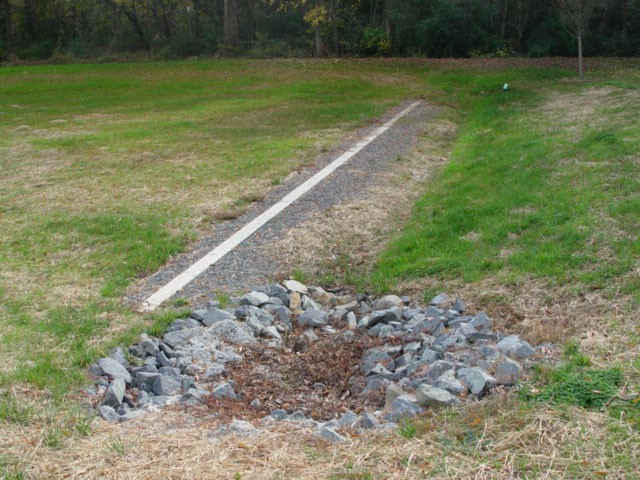Level Spreader

Definition
A level spreader is an excavated depression constructed at zero percent grade across a slope. The level spreader changes concentrated flow into sheet flow and then outlets it onto stable areas without causing erosion. It allows concentrated runoff to be discharged at non-erosive velocities onto natural or man-made areas that have existing vegetation capable of preventing erosion. An example would be at the outlet of a diversion or a waterway.
Where Practice Applies
- Where it can be constructed on undisturbed soils and a level lip can be installed without filling.
- Where the area directly below the spreader is stabilized by existing vegetation.
- Where water will not re-concentrate immediately below the spreader, and water can be released in sheet flow down a stabilized slope without causing erosion.
- Where there is at least 100 feet of vegetated area between the spreader and surface waters.
- Where the area below the spreader lip is uniform with a slope of 10 percent or less and is stable for anticipated flow conditions.
- Where there will be no traffic over the spreader.
Advantages
Level spreaders are relatively low cost structures designed to release small volumes of water safely. Level spreaders disperse the energy of concentrated flows, reducing erosion potential and encouraging sedimentation.
Disadvantages/Problems
If the level spreader has any low points, flow will tend to concentrate. This concentrated flow can create channels and cause erosion. If the spreader serves as an entrance to a water quality treatment system, short-circuiting of the forebay may happen and the system will be less effective in removing sediment and particulate pollutants.
Planning Considerations
- Diversions and waterways need a stable outlet for concentrated stormwater flows. The level spreader can be used for this purpose if the runoff is relatively free of sediment. If properly constructed, the level spreader will significantly reduce the velocity of concentrated stormwater and spread it uniformly over a stable undisturbed area.
- Placement of the level spreader must allow the water flowing over the level section to leave the structure as a uniform, thin film of water.
- The structure should outflow onto naturally vegetated areas whenever possible. The creation of a uniform level lip for the water to spread over is critical.
- Particular care must be taken during construction to ensure that the lower lip of the structure is level. If there are any depressions in the lip, flow will tend to concentrate at these points and erosion will occur, resulting in failure of the outlet. This problem may be avoided by using a grade board or a gavel lip over which the runoff must flow when exiting the spreader. Regular maintenance is essential for this practice.
- Water containing high sediment loads should enter a sediment trap before release in a level spreader.
Design Recommendations
- Drainage area should be limited to five acres.
- The grade of the channel entering the level spreader should be no steeper than 1 percent.
- The level spreader should be flat ("0 percent" grade) to ensure uniform spreading of storm runoff.
- The design length for a level spreader should be no more than 0.5 cfs per foot of level section, based on the peak rate of flow from the contributing erosion control or stormwater management practice.
- The width of the spreader should be at least 6 feet.
- The depth of the spreader as measured from the lip should be at least 6 inches and it should be uniform across the entire length.
- The spreader shall be stabilized with an appropriate grass mixture.
- The spreader should be mulched if necessary for the establishment of good quality vegetation.
- The level lip may be protected with an erosion stop and jute or excelsior matting. The erosion stop should be placed vertically a minimum of six inches deep in a slit trench one foot back from the crest of the level lip and parallel to the lip. The erosion stop should extend the entire length of the level lip. Two strips of jute or excelsior matting can be placed along the lip. Each strip should overlap the erosion stop by at least six inches.
- The area downslope should have a complete vegetative cover sufficiently established to be erosion resistant.
Maintenance
- The level spreader should be checked periodically and after every major storm.
- Any detrimental sediment accumulation should be removed.
- If rilling has taken place on the lip, the damage should be repaired and re-vegetated.
- Vegetation should be mowed occasionally to control weeds and encroachment of woody vegetation. Clippings should be removed and disposed of outside the spreader and away from the outlet area.
- Fertilization should be done as necessary to keep the vegetation healthy and dense.
- The spreader should be inspected after every runoff event to ensure that it is functioning correctly.
References
Massachusetts Department of Environmental Protection, Office of Watershed Management, Nonpoint Source Program, Massachusetts Nonpoint Source Management Manual, Boston, Massachusetts, June, 1993.
Minnick, E. L., and H. T. Marshall, Stormwater Management and Erosion Control for Urban and Developing Areas in New Hampshire, Rockingham County Conservation District, August 1992.
Washington State Department of Ecology, Stormwater Management Manual for the Puget Sound Basin, Olympia, WA, February, 1992.